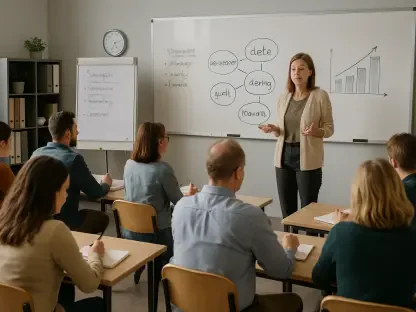In a rapidly evolving educational landscape, the integration of technology into classrooms has become increasingly paramount. A recent survey conducted by SMART Technologies’ Lumio software has shed light on the patterns, preferences, and challenges faced by educators as they navigate the realm of educational technology. The survey’s results unveiled a strong inclination among teachers to incorporate digital tools, though it also highlighted several hurdles that hinder seamless adoption. As educators strive to enhance student engagement and personalize learning experiences, understanding the current state of technology use in education is crucial.
Adoption and Usage Patterns
Integration of Digital Tools
One of the key insights from the survey is the high frequency with which educators incorporate technology into their lessons. Remarkably, 85% of teachers reported using digital tools multiple times a week, with many integrating technology on a daily basis. This widespread adoption underscores the importance educators place on technological resources in fostering an engaging and dynamic learning environment. Notably, 40% of respondents described their relationship with technology as essential, indicating a deep reliance on these tools to enrich the educational experience.
This commitment to technology is further emphasized by the fact that 72% of teachers consider themselves tech-savvy, confident in their ability to navigate and leverage digital tools for instructional purposes. Additionally, 70% feel proficient in supporting a diverse range of learners, including neurodivergent students and those who require additional assistance. The ability to cater to a wide spectrum of learning needs is a significant advantage of educational technology, as it allows for more tailored and inclusive teaching approaches.
Enhanced Student Engagement and Personalized Learning
Over a third of teachers highlighted enhanced student engagement as a primary benefit of using educational technology. Interactive displays, multimedia resources, and gamified learning experiences can captivate students’ attention more effectively than traditional methods. These tools not only make learning more enjoyable but also foster active participation, which is crucial for deep comprehension and retention. By leveraging technology, educators can create immersive and interactive classrooms that resonate with students.
Moreover, the capacity to personalize learning was another prominent advantage mentioned by educators. Digital tools enable teachers to tailor lessons to individual students’ needs, accommodating different learning paces, styles, and preferences. For instance, adaptive learning software can provide customized content and exercises, ensuring that students receive the appropriate level of challenge and support. This personalization fosters a more student-centered approach, where learners can progress at their own pace and receive targeted assistance when necessary.
Challenges and Preferences
Technical Reliability and Support
Despite the numerous benefits, technical issues remain a significant hurdle for educators. The survey revealed that 30% of teachers cited technical problems as a major challenge, underscoring the need for reliable technology and consistent technical support. Malfunctions and disruptions can be highly frustrating, hampering the flow of lessons and causing unnecessary stress for both teachers and students. Ensuring that classroom technology functions smoothly is essential for maintaining an effective and efficient learning environment.
Another critical concern highlighted by educators is the outdated nature of their classroom technology. Over half of the respondents (56%) reported that their existing tech tools are obsolete, impeding effective teaching and learning. Antiquated devices and software can limit the scope of educational activities, preventing teachers from fully capitalizing on the potential of digital resources. This challenge underscores the pressing need for schools to invest in up-to-date and cutting-edge technology to support modern educational practices.
Student Distraction and Management
Student distraction, particularly due to cell phone use, emerged as another significant issue. According to the survey, 25% of educators identified it as a key challenge, and nearly 40% viewed cell phones as a considerable distraction in the classroom. The constant notifications and accessibility of social media can easily divert students’ attention, detracting from the learning process. Managing these distractions requires a balanced approach, as outright bans on cell phones may not be practical or effective.
Interestingly, only 23% of teachers viewed cell phones as beneficial when managed properly. This finding suggests that while there is potential for mobile devices to be used as learning tools, it requires careful regulation and structured guidelines. Establishing clear policies on cell phone use, incorporating them into lesson plans in a controlled manner, and educating students about responsible usage are strategies that can help mitigate distraction and harness the educational benefits of these devices.
Addressing Time Constraints
Planning and Review Time
One of the most pressing concerns for educators is the substantial amount of personal time dedicated to planning lessons and reviewing assignments. This time commitment often comes at the expense of personal activities and work-life balance. Consequently, there is a strong demand for ready-made lesson content that can alleviate the time burden on teachers. Pre-prepared resources can streamline the planning process, allowing educators to focus more on delivering impactful instruction and providing personalized support to students.
To address these issues, SMART Technologies aims to provide tools like Lumio that enhance interactivity and collaboration in the classroom. By streamlining lesson creation and offering a repository of high-quality content, such platforms can help reduce the time teachers spend on administrative tasks. This, in turn, enables educators to devote more attention to their personal well-being and professional development, ultimately leading to a more balanced and sustainable teaching career.
Professional Development and Training
Effective integration of technology also necessitates ongoing professional development and training for teachers. As new tools and platforms emerge, educators must stay abreast of the latest advancements and pedagogical strategies. Continuous learning opportunities empower teachers to harness the full potential of educational technology, adapt to evolving trends, and implement best practices in their classrooms. Professional development programs should therefore be prioritized, providing educators with the skills and knowledge needed to navigate the digital landscape confidently.
Future Prospects and Solutions
Addressing Current Challenges
The findings of the SMART Technologies survey highlight a dual aspect of technology integration in education: while digital tools offer substantial benefits in terms of student engagement and personalized learning, significant challenges persist. Addressing these issues requires a multi-faceted approach that includes updating classroom technology, providing robust technical support, and offering ready-made lesson content to ease teachers’ workload. By enhancing the reliability and accessibility of technology, schools can create a more conducive environment for effective teaching and learning.
Embracing Innovation and Collaboration
Educators are striving to leverage digital tools to foster a more interactive and personalized learning environment. However, understanding teachers’ difficulties can provide valuable guidance on improving tech adoption in education. Addressing these challenges is crucial to propelling forward the purposeful use of technology, ultimately enhancing the learning experience for students.









